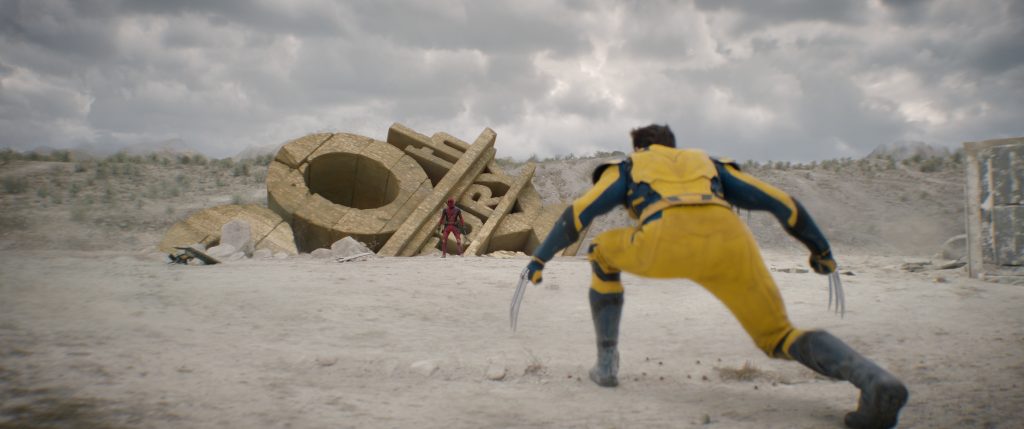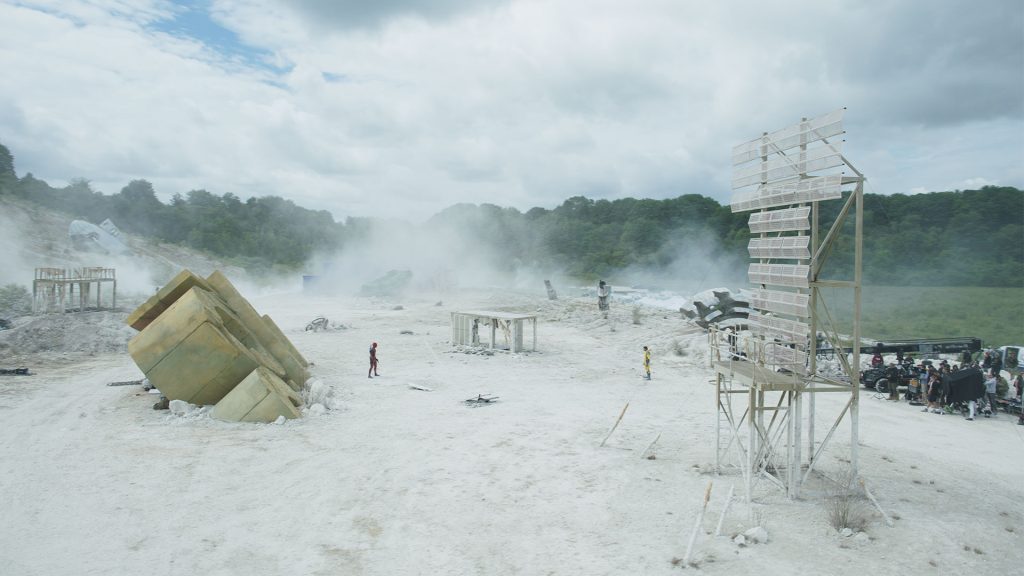The visual effects supervisor talks Cassandra Nova, Gambit, and more.
By Dan Brooks

In a surprise twist midway through Deadpool & Wolverine, our titular protagonists are marooned in the Void: a Mad Max-like wasteland of desert and forgotten heroes. Their time in this multiverse purgatory takes up a significant chunk of the movie and features many of its greatest moments, from surprise character appearances to action set pieces, and Industrial Light & Magic was charged with bringing it all to the screen. Just from reading the script, visual effects supervisor Vincent Papaix knew that this section of Deadpool & Wolverine would be key to the movie’s overall success.
“Everybody was super motivated,” he tells ILM.com, “and we all knew that this movie was going to be special.”
Deadpool & Wolverine went on to become the biggest R-rated movie of all time following its theatrical release this summer, a true cinematic event during a challenging time for the film industry. To mark its arrival on Disney+, ILM.com caught up with Papaix to discuss how ILM realized some of the blockbuster’s impressive visual effects in the Void sequences. Grab a chimichanga and join us.

A sunny day in the Void
As fantastical as the Void may sound, director Shawn Levy and star/producer Ryan Reynolds (Deadpool) aimed to make it a believable setting and something that fans could relate to. “They really wanted it to feel as grounded and real as possible,” Papaix says. To achieve this, the filmmakers started the old-fashioned way, more or less.
“One thing for them was to shoot in natural conditions. That’s why most of the shoot was outdoors,” Papaix says. “So they shot in a landfill in the UK and in various locations in the UK to get that kind of natural light feel.”
This did create certain challenges, however. “You don’t control the elements,” Papaix says simply.
When Deadpool and Wolverine (Hugh Jackman) first arrive in the Void, they quickly proceed to beat the tar out of each other. This fight was shot outdoors in summer 2023 and then, due to the writers’ and actors’ strikes, finished in winter 2024. As a result of the pause and change in seasons, the color of the sky appeared slightly different. Though Levy and Reynolds initially hoped to digitally correct any inconsistencies in the look of the sky, ILM encouraged the filmmakers to keep this to a minimum. “One thing that was great about working with Shawn and Ryan and [Marvel visual effects supervisor] Swen Gillberg was that they are very collaborative,” Papaix says. “We did a few shots and a few tests and we realized the best outcome was to embrace the plate. So, based on the plate, if it’s sunny, let’s try to augment that. If it’s stormy, let’s try to be more stormy and then we’ll look at how it plays in the cut. And every shot was kind of hard to direct in that way. It’s making sure that it plays nicely, but if you look at the sequence, there’s some variation as you would have in a natural daylight. You can be in an area and within 10 minutes it can be from sunny to cloudy to stormy, depending on what is happening. So we focused on making it look as real as you can.”
Finally, to increase the grandeur of the Void, from scale to background elements, ILM came in to digitally augment what was captured in-camera.
“Our work was focusing on creating a seamless transition from the foreground set to a CG extension of the Void,” Papaix says. “Overseeing adding everything that was needed to the Void, including the detritus. There are all those different objects scattered throughout the Void. So obviously [we were] making sure they integrated, but the Void needed to feel real, and not feel like the foreground was on a stage in bluescreen extended into a CG world.”


A new villain emerges
The evil twin of Charles Xavier, Cassandra Nova (Emma Corrin) debuts in Deadpool & Wolverine as the ultimate authority in the Void. Unpredictable and hugely powerful, she’s a frightening villain that Wolverine and Deadpool must overcome. With guidance from Levy and Reynolds, ILM set out to illustrate her abilities in a subdued but unnerving way.
“She can control a lot of things with her mind,” Papaix says. “They wanted something fairly subtle to not overpower what was the power. It was important to show what it was doing to the people and not too much to [show] the power itself, not too much magic or anything. So it was more a subtle distortion to explain that there’s something happening.”
And what Cassandra does is indeed creepy: She seems to have a predilection for passing her fingers through the skulls of her enemies, including the Merc with a Mouth.
“We went through different aspects, from being creepy and caressing his face with almost spider-like fingers. All that was digital and a very complex simulation to kind of deform the masks in CG. What gets tricky is that it’s easy to do a collision, but we had to do a half collision and half penetration going through. So that’s actually a very complex simulation to control. And it was fully art-directed, meaning we had to control every aspect of the effect. We started with the performance of the fingers, and once we had the right emotion, then we worked on the simulation of how the mask should deform and, at the same time, kind of breaks open to let the finger go through.” In the end, Papaix was more than happy with the result.
“I read a lot of great reactions. People felt an itch, a little bit. It feels creepy but in a good way, because that’s definitely what the filmmakers were after.”

Johnny Storm’s quick exit
Cassandra sends Johnny Storm (Chris Evans reprising his original Marvel role from the Fantastic Four films) to a truly unfortunate demise, ripping off his skin and driving him into the ground. It’s a shocking moment—gruesome with a dark sense of humor—in a movie full of them.
“This was part of the script from day one,” Papaix says. “That was a moment that was very important for the filmmakers.” But where to begin for an effect so unlike anything previously seen in a Marvel movie? “Ripping out the skin was very graphic, so we had to study images.”
ILM turned to Real Bodies: The Exhibition, a long-running museum showcase that features actual human specimens, for reference. It made for a decidedly unique creative process. “The real [body in the exhibit] is very dry and has been preserved. We wanted to make it look fresh, so we had to add a lot of blood and liquids to make sure we felt that this just happened. So we are dripping blood, dripping fat. That was very gross. The daily session with the artists was always interesting.”
Once ILM knew how the effect should look, they began building a digital Johnny.
“The way we proceeded with this was creating an asset,” Papaix explains. “So a skeleton asset, we called it, with all the flesh and all the organs in there. We based everything, all the proportions, on Chris Evans. We have his scan. We created a digital version of Chris for Johnny Storm, even for the Human Torch version when he was on fire.”
Then it was time to get down to the de-skinning business.
“So we started from that and then we ripped off his skin. It’s pretty much what you can imagine, but in CG,” Papaix says with a laugh. “The shell of the clothes and skin were removed, revealing the skeleton with all the flesh. We tried to create some strings of blood coming out of him.” In an effort to maintain the series’ comedic tone, ILM added some elements to hopefully make this scene a little more Looney Tunes and less Hellraiser.
“It was kind of a cartoony moment, but in a good way — he has that moment blinking his eyes, and it’s like, ‘What just happened to me?’ And then he drops.”


Gambit gets his day
The Void segment culminates with Deadpool, Wolvie, and a band of fan-favorite heroes launching a siege against Cassandra and her forces. While fans delighted at seeing each back in action, one required visual effects that are essential to the character.
“A lot of attention was put to Gambit [Channing Tatum],” Papaix says. “We studied a lot of the comic books to see what was happening with his cards and [mutant power].” In the comics and iconic X-Men cartoon, Gambit charges playing cards, resulting in a purple glow; when he tosses them, they leave a trail and explode on impact. “We went for a various range of showcasing the power to the point that I remember a version where we probably went too far — too glowy and too flamey-looking. And that’s something that was not pleasing to Shawn, for good reason. He wanted to be grounded, again, to reality. So the cards — it’s the X-Men and all, but it’s important to have the cards telling the story.”
As a solve, ILM illustrated a slower buildup of Gambit’s mutant power. “We were focusing mostly on the card and the energy within the card. There was a closeup in the cavern, when you see the card activating, and it’s within the pattern of the card. For the battle, we made some trails to be able to see it, because a card is very small. True to the comic.”


A lasting collaboration
Deadpool & Wolverine is a success for Papaix on several levels, from the commercial and critical reception to more personal reasons.
“I had the chance to work on the first Deadpool in 2016. Time flies. So this one already was quite special in my career, and having the opportunity to supervise the third one was also quite special. Knowing that Hugh Jackman was attached as Wolverine, there were so many good things.”
But looking back at the film, he seems to mostly value the time with Levy, Reynolds, and Marvel. “They were great collaborators. Obviously, he’s a director and he makes his call, but he was very keen on hearing people’s suggestions. But the collaboration for me is one of the highlights of the show with Swen and with Marvel, and pitching those ideas to Shawn and Ryan. They also thanked us. We know that’s something that not every filmmaker does, but at the end of the project we got a thank you video from Ryan and Shawn to share with our team at ILM, and it’s always fun to see that they appreciate the work. Obviously, they see the people on set, but when you do post-production, they receive the image. So they don’t really realize that we were 275 people making this happen. We did about 30 minutes of the movie, 614 shots, but it was a global team. It was mostly Vancouver and San Francisco, but also other ILM sites working with us. But it was 275 people. That’s quite a big group of people making it up to show those crazy visual effects on screen.”

—
Dan Brooks is a writer who loves movies, comics, video games, and sports. A member of the Lucasfilm Online team for over a decade, Dan served as senior editor of both StarWars.com and Lucasfilm.com, and is a co-author of DK Publishing’s Star Wars Encyclopedia. Follow him on Instagram at @therealdanbrooks and X at @dan_brooks.